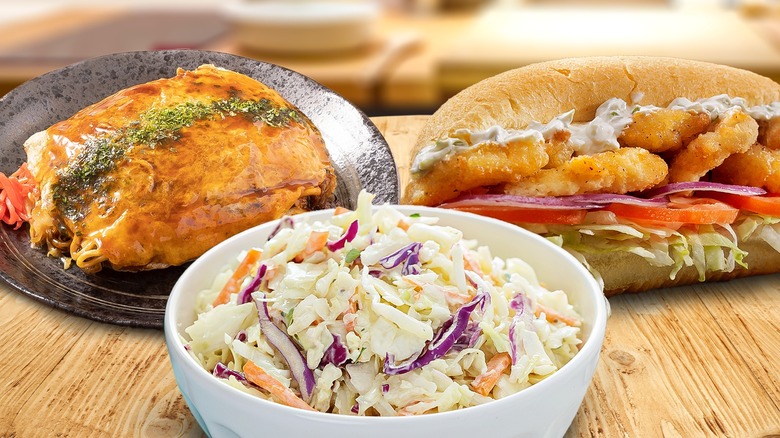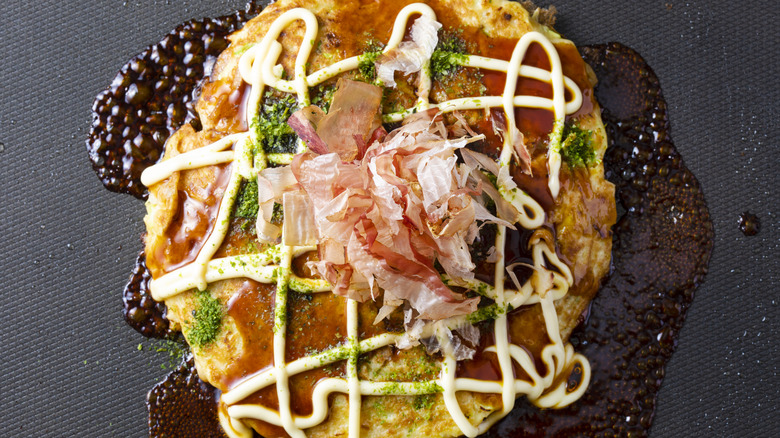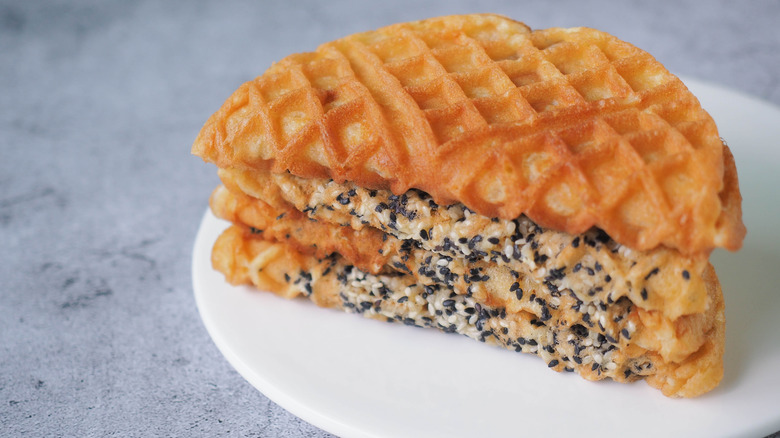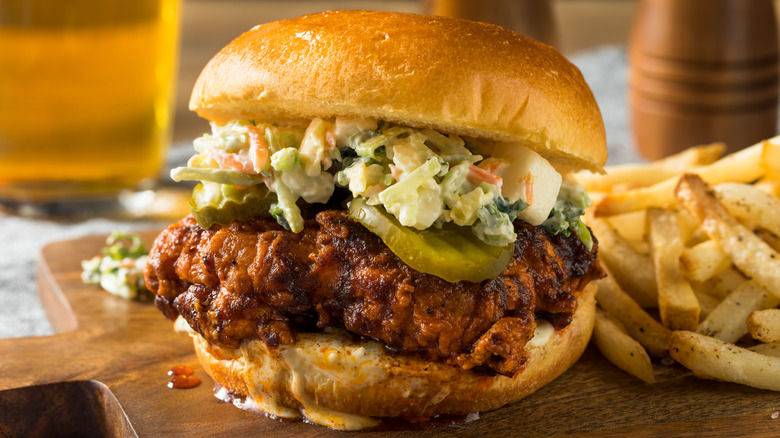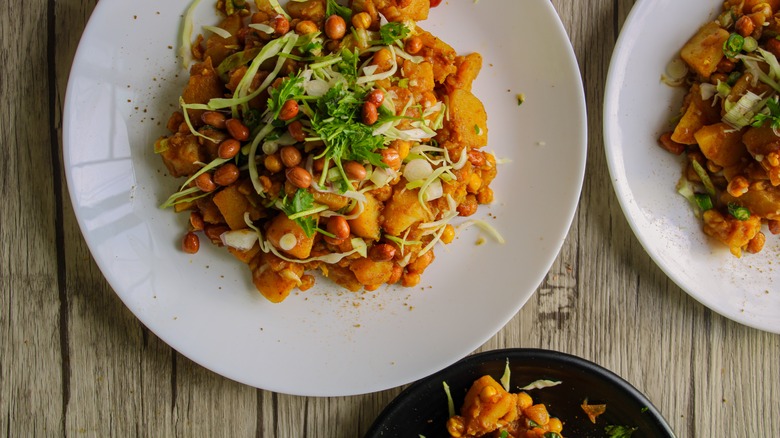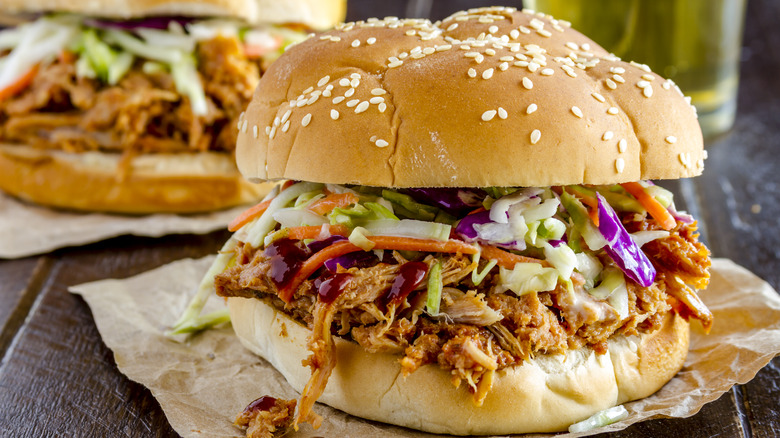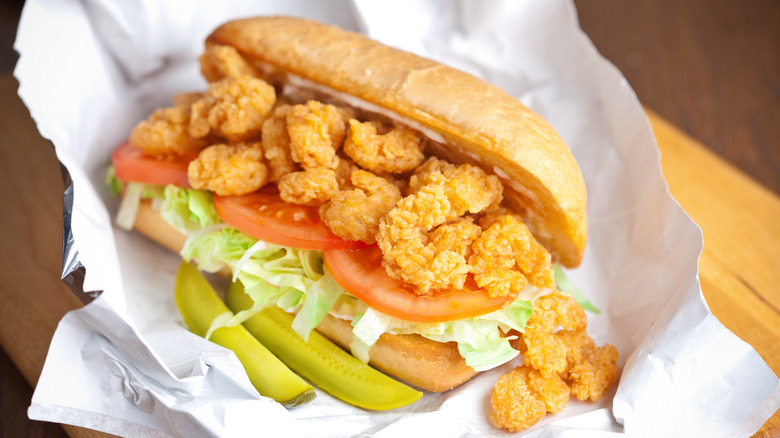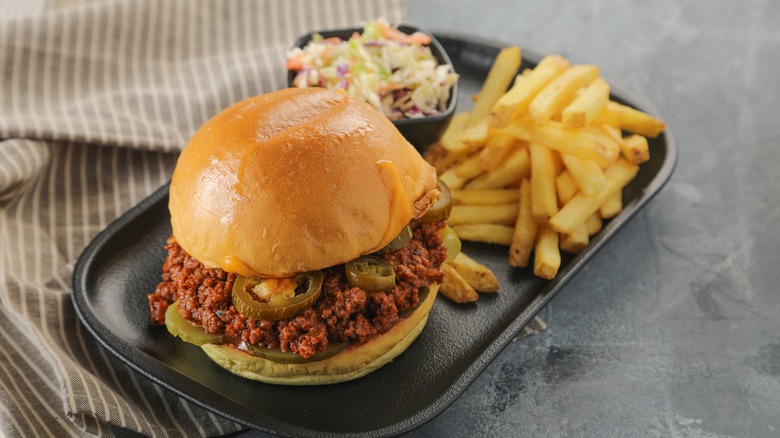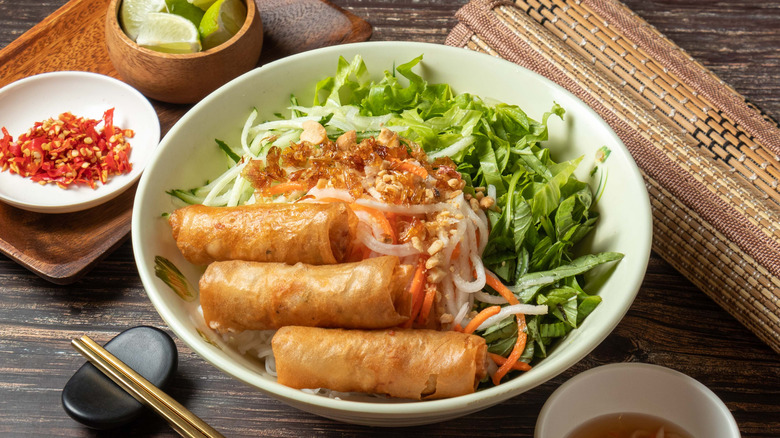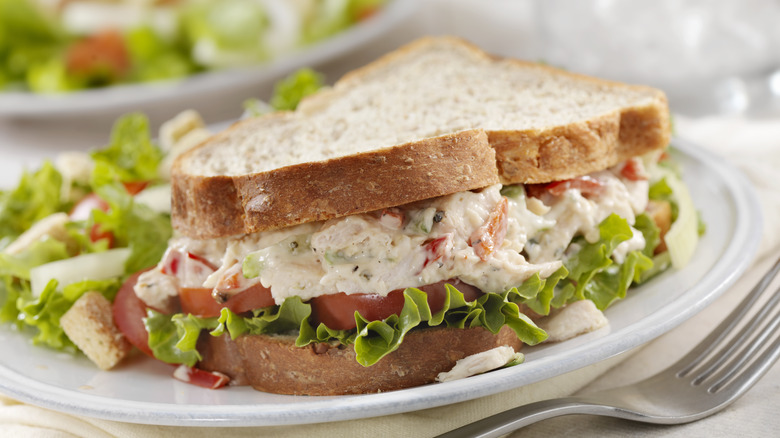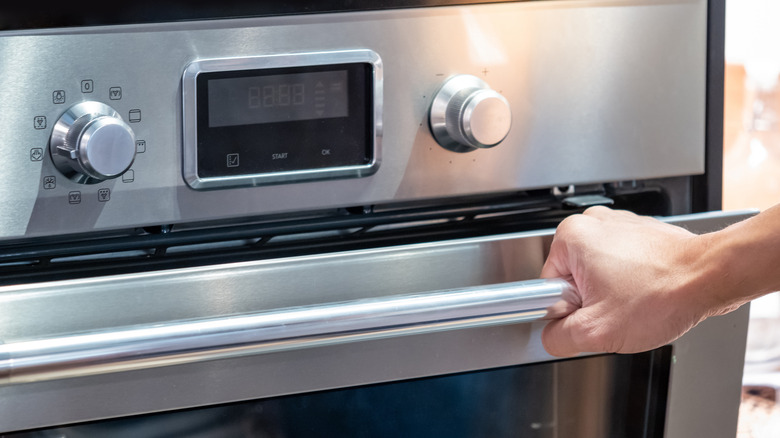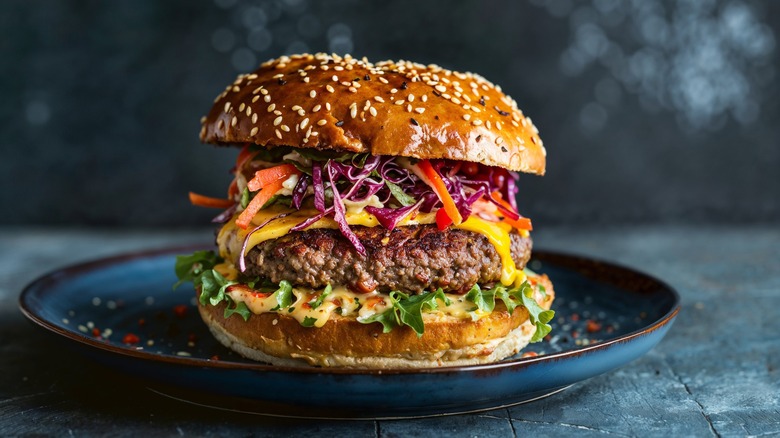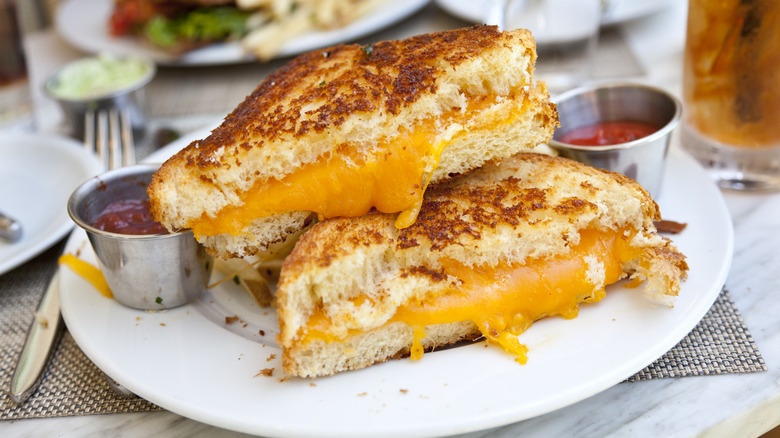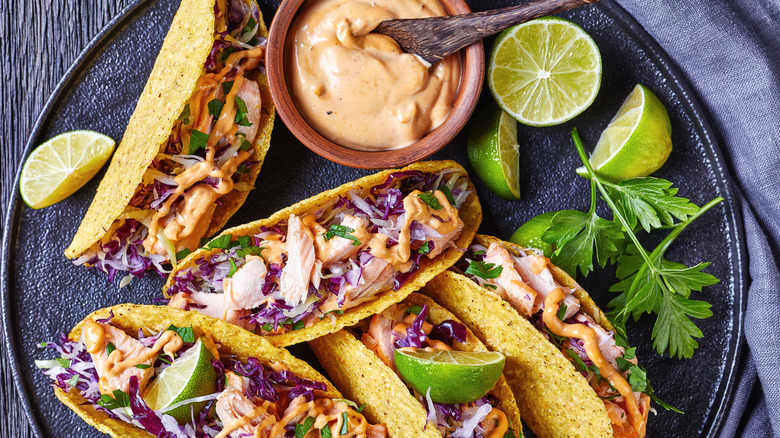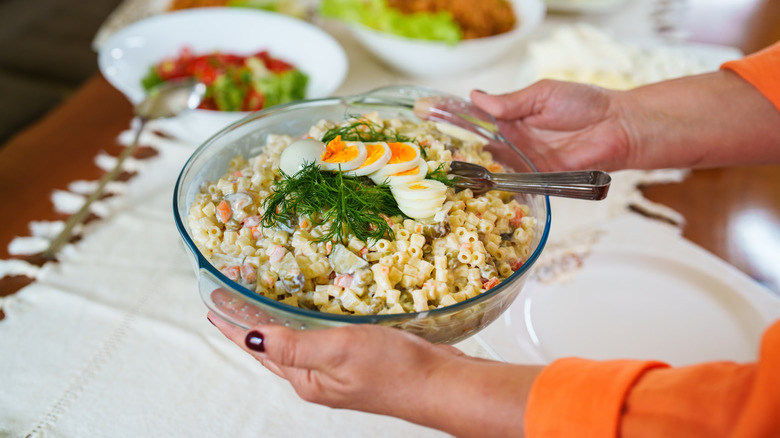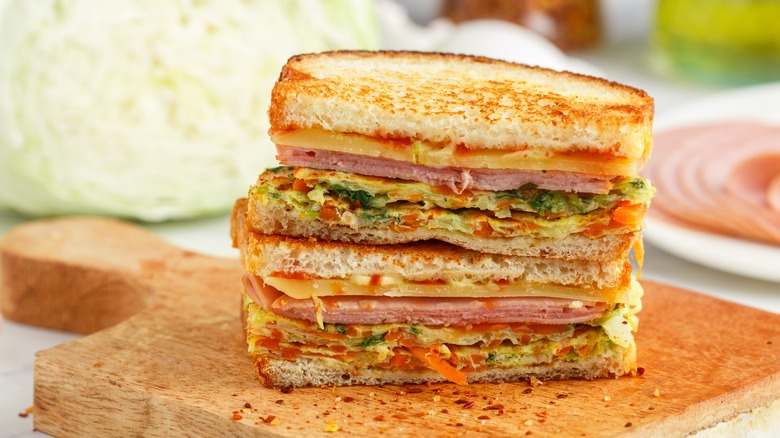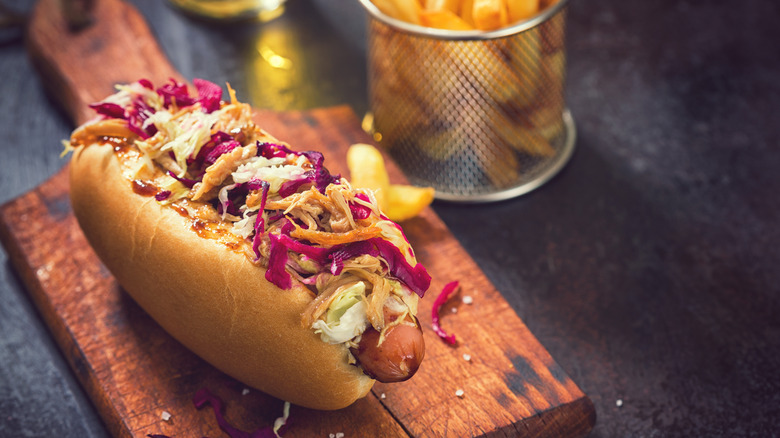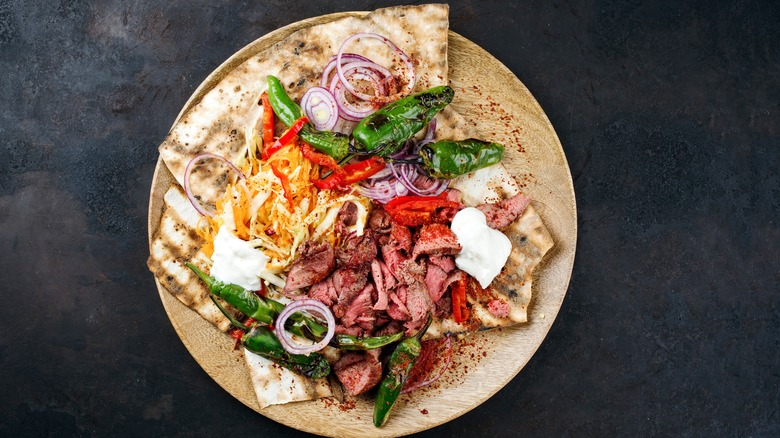17 Ways To Use Up Leftover Coleslaw, According To An Expert
When life gives you cabbages, make coleslaw. In fact, make as much as will fit in your favorite Tupperware container. This crunchy, tangy, irreplaceable element of American barbecue comes in endless variations — many recipes contain cabbage, carrots, mayo, and vinegar — so it's worthwhile to find your favorite version and keep a supply of it on hand.
I know what you're thinking of. It's true: Leftover coleslaw tends to amass in the back of the refrigerator after the last fingers have been licked clean of hot dogs and hamburgers. But coleslaw (homemade or store-bought) is one of those dishes that can be repurposed in a hundred different ways. Instead of ignoring its desperate cries, the last thing to do before throwing out soggy coleslaw is to drain its excess liquid, add extra vegetables and/or dressing, and incorporate it into another meal. Dry coleslaw offers even more versatility and lends itself well to a range of international cuisines.
In this guide, I suggest 17 ways to use leftover coleslaw based on my experience working in a professional kitchen at a bed and breakfast. There are options for dressed and undressed slaws, as well as purple and green variations. Knowing how to capitalize on leftover coleslaw can make meal prep more efficient and add a creative twist to what might otherwise be a monotonous meal. It also helps reduce food waste, giving both your wallet and our planet a break. So before your coleslaw goes rancid or develops mold, make the most of it!
1. Mix it into okonomiyaki
Okonomiyaki is an easy-to-make Japanese street food dish that can be used as a blank slate for all kinds of leftover meats and vegetables. Sometimes described as a savory pancake, okonomiyaki's star ingredient is shredded cabbage, with recipes frequently including shredded carrots as well. Both ingredients crisp up nicely when mixed into a batter and cooked on a skillet, and both ingredients are also coleslaw mainstays, making it easy to see why coleslaw can be used as a quick substitution. It's important to use undressed coleslaw here since the dressed version would result in a textural nightmare: Think of the last time your pancake batter was too runny, and you get the picture.
After mixing the coleslaw with a few other okonomiyaki components, like flour, eggs, and scallions, cook the batter in a skillet until sufficiently browned and then top with ingredients like Kewpie mayonnaise, okonomiyaki sauce, furikake, and pickled ginger. Feel free to get creative here; the name "okonomiyaki" is rooted in the word "okonomi," which literally means "as you like it." To get started, try this okonomiyaki recipe from Xiao Bao Biscuit, a Charleston pan-Asian restaurant.
2. Add it to sesame scallion waffles
Inspired by Chinese and Korean scallion pancakes, sesame scallion waffles are a versatile, savory treat that will upgrade your meal. While scallion pancakes have a signature flaky texture that requires time and meticulous attention to achieve, sesame scallion waffles are quick to make. Yet, their simple ingredients nevertheless pack an incredible flavor. The scallions, sesame seeds, and five-spice powder warm you up from the inside out, especially if you use a powder that's heavier on the Sichuan peppercorns.
These warm (but not spicy) tones are why coleslaw pairs so well with sesame scallion waffles. Swap the slab of butter and drizzle of maple syrup used on traditional waffles for a heaping scoop of coleslaw, preferably made with purple cabbage and massaged in an Asian-inspired coleslaw dressing. This dressing could potentially include soy sauce, hoisin sauce, sesame oil, hot peppers, and/or rice vinegar, depending on the balance of sweet, tangy, salty, and spicy you wish to achieve.
3. Pair leftover coleslaw with fried chicken
Fried chicken tastes great with many things, but coleslaw brings something special to this iconic comfort food. It's no wonder why KFC's coleslaw is such a popular side item! Whether you are eating fried chicken on a biscuit, waffle, or plate by itself, your taste buds will be pleased if you add a heap of coleslaw.
Because there are many styles of fried chicken around the globe, including Korean fried chicken, Southern fried chicken, chicken 65, and chicken Kiev, you can adapt your slaw to complement the cuisine on hand. For instance, if eating Japanese karaage, use kewpie mayonnaise and lemon juice in your dressing.
Spicier chicken dishes, like this spicy buttermilk fried chicken recipe, benefit from the cooling nature of coleslaw. If you don't eat chicken, try substituting the meat with a recipe for crispy Nashville hot tofu; tofu provides a clean palette for adding flavors, and when made spicy, both its texture and heat are well balanced by crunchy, cooling coleslaw.
4. Give an Indian twist
You can give classic coleslaw some sweet heat with one ingredient: hot honey. If you are working with undressed coleslaw, this substitution is especially delicious when incorporated as a side in Indian cuisine. Replace the sugar in your coleslaw dressing with half the amount of hot honey for a slightly hot coleslaw that adds complexity to dishes like aloo paratha. Alternatively, forgo the hot honey and keep your coleslaw cool. Use it as a replacement for kachumber, an Indian salad traditionally served alongside Indian curries, rice dishes, and dal chawal sabji.
In either case, you'll need to make a few substitutions to ensure your flavors are complementary: Try replacing half the mayonnaise with yogurt and adding a pinch of coriander powder and toasted cumin seeds to the dressing. You can also mix a handful of toasted cashews or peanuts into the coleslaw or garnish it with chopped cilantro.
5. Jazz up pulled pork sandwiches
Pulled pork can be time-consuming, but recipes fine-tuned over generations stand testament to the fact that this Southern dish is incredibly flavorful, comforting, and worthy of the pride people take in their families' recipes. Besides, there's no shame in using a slow cooker for a low-maintenance dinner. Pulled pork is typically eaten on sandwiches with crisp, sharp, and fresh coleslaw. It contrasts the bun's pillowy softness and the slow-cooked pork's tenderness.
If you're looking for a more creative way to enjoy pulled pork, this meat is frequently eaten in tacos and quesadillas, egg rolls, and lettuce cups, which are all a great way to use leftover coleslaw dressing. Wherever pulled pork exists, there's a place for leftover coleslaw, too. However, if you prefer a vegetarian alternative, try this jackfruit BBQ sandwich recipe. To make it entirely vegan, use vegan mayo instead of the regular kind.
6. Layer it in po' boy sandwiches
Po' boys may be messy to eat, but the two slices of French bread on which they are served nevertheless add a hint of elegance to this traditional New Orleans sandwich. Po' boys are typically filled with some kind of meat or seafood, such as crab, roast beef, ham, or pork, while oyster mushrooms and tofu are common vegetarian substitutes. Meanwhile, possible condiments include remoulade sauce, mayonnaise, dill pickle, cheese, lettuce, tomatoes, and more.
There are many regional variations of po' boys, so don't feel afraid to experiment. For starters, you can replace or supplement the lettuce with coleslaw (dressed or undressed). This swap works particularly well because mayonnaise and remoulade sauce are already key ingredients on po' boys (use one or the other). Remoulade sauce, which frequently features ingredients like mayonnaise, mustard, ketchup, and horseradish, can even be used as an exceptionally flavorful coleslaw dressing.
7. Add leftover coleslaw to sloppy Joes
Sloppy Joes consist of ground beef and onions cooked in a tomato-forward sauce, sandwiched into a hamburger bun. They are quick to whip up and make for a hearty lunch or dinner. The meat filling can even be added to spaghetti, helping solve disagreements about what to have for dinner. Another variation is to use lentils instead of meat; indeed, instant pot lentils are the perfect vegetarian swap for sloppy Joes.
Sloppy Joes typically don't have many condiments because the meat mixture is flavorful and moist enough on its own. But if you do want to add a condiment, coleslaw is the way to go. It is not an unusual pairing; a Reddit user wrote, "Every sandwich can be improved with coleslaw, sloppy ones most of all." Coleslaw pairs well with the savory meat filling and provides a crunchy contrast to the hamburger bun.
8. Stuff it in egg rolls or spring rolls
Egg rolls and spring rolls traditionally call for shredded cabbage, but coleslaw is the store-bought item that makes prepping homemade egg rolls a breeze. Indeed, a bag of undressed coleslaw removes the tedious process of rinsing, drying, and slicing this leafy green vegetable. It even lets you skip over the step of julienning carrots! Most importantly, taking this shortcut allows you more time and leaves you more patience for the most difficult step in making these popular appetizers: keeping the wrappers intact and all the vegetables inside during the rolling process.
Egg roll and spring roll recipes commonly call for Napa cabbage, but several varieties of green cabbage and red cabbage-based coleslaws are suitable, with each kind offering a different flavor profile. To make rolling easier, chop your coleslaw mix of choice in a food processor until it reaches the appropriate size.
9. Give tomato sandwiches a crunch
What better way to use leftover coleslaw than in a good ol'-fashioned tomato sandwich? These sandwiches typically feature mayonnaise already, so it's safe to add dressed coleslaw without muddling the flavors. Coleslaw provides a nice textural crisp that matches the tomatoes' skin while keeping the sandwich light enough to eat on a hot summer's day — or any day.
To avoid a soggy sandwich, brush a light layer of butter or mayonnaise inside each slice of bread before building your sandwich. The fat found in each ingredient acts as a protective barrier to keep moisture from seeping into your bread. This is an especially smart idea if you're not eating the sandwich right away because coleslaw introduces another element of moisture to bread that must be taken into consideration. With this knowledge, you can bulk up your next tomato sandwich with a slather of slaw now.
10. Roast leftover coleslaw in the oven
If raw cabbage just isn't your thing, you can roast leftover coleslaw to give it a new, tasty life. The cabbage will attain crisp edges yet remain tender in the middle and bring out a somewhat sweeter flavor. The hint of spiciness that can otherwise accompany some varieties of cabbage is simultaneously eliminated. The reason for this transformation? Heat persuades the natural sugars found in cabbage to come out and play. Add tart apples to your coleslaw to further complement this culinary process; their flavors will similarly mellow when roasted.
Coleslaw is best roasted at a high heat and with a drizzle of olive oil to encourage crispiness. For the ideal texture, you will need to drain any excess liquid from the slaw before placing it in a thin layer in a baking dish (evaporation will only take care of so much). Serve roasted coleslaw warm alongside any of the dishes on this list.
11. Switch up your burger toppings
When thinking of how to dress your burger, the sheer number of possibilities can seem overwhelming at first. J. Kenji López-Alt, author of "The Food Lab: Better Home Cooking Through Science," identifies five flavor and three texture categories for burgers, per Serious Eats. The flavor categories include components like fresh, tart or pickled, and sweet. Meanwhile, texture refers to crunchy or crisp, gooey, and moist. A single burger should incorporate a few of these categories by mixing and matching ingredients.
Dressed coleslaw is an ingredient that checks multiple boxes: It is certainly fresh, tart, and crunchy, with elements of gooey and moist. You won't need many other toppings if you include coleslaw, but you could pair coleslaw with baked beans for an unexpectedly delicious burger topping. Though both meat-based and vegetarian burgers benefit from the addition of coleslaw, patties with a soft consistency are a particularly good choice.
12. Lend grilled cheese sandwiches more depth
Grilled cheese sandwiches never get old, especially when you start to experiment with a wide range of breads, cheeses, and toppings. When making any grilled cheese sandwich, you want to choose a cheese with the right amount of fat; otherwise, it will not give you that satisfying "cheese pull" when melted. In addition to texture and melting properties, you should take a moment to consider the flavors at play and how filling you want your sandwich to be.
Pairing coleslaw with a grilled cheese sandwich is an especially wonderful option when baby Swiss or mild provolone is used. Both varieties rank among the best cheeses for your grilled cheese sandwich because, in addition to offering a great cheese pull when heated, they are less mature varieties of cheese with more mellow flavor profiles. Their low-intensity, subtle flavors allow add-on ingredients like dressed coleslaw to really shine. Don't stop there, though. Try adding other complementary ingredients for a more robust meal. For example, upgrade a grilled ham and cheese sandwich with a spoonful of coleslaw.
13. Add fresh flavors to tacos
When setting up your next taco bar, don't forget to pull out the coleslaw! While it stands apart from traditional fare like salsa, onions, guacamole, and pico de gallo, coleslaw (either dressed or undressed) can nevertheless add both aesthetic brightness and vibrant flavor to all kinds of tacos. Fish and shrimp tacos are popular seafood options that benefit from the tangy flavor of coleslaw, while this chile-lime sweet potato and chickpea sheet-pan tacos recipe is a vegetarian choice that would benefit from coleslaw's crunchy texture and fresh flavors.
Depending on the base of your tacos, consider modifying your leftover coleslaw's dressing or ingredients. For instance, tacos al pastor, which features pork and pineapple, would go well with coleslaw that has been made spicy with jalapeños or chile peppers. On the other hand, chickpea tacos would benefit from a sprinkling of parsley or cumin powder.
14. Create a pasta salad with leftover coleslaw
Pasta salad traditionally includes vegetables like celery, cucumber, carrots, and onions — all ingredients commonly found in coleslaw. Additionally, aside from oil-based pasta salads, both dishes call for dressings featuring mayonnaise and vinegar. It makes sense why coleslaw can so easily be integrated into this picnic staple. Cold pasta salad, made even more refreshing by coleslaw, is exactly what you need on a hot summer's day.
If your coleslaw is undressed, simply use it in place of the vegetables you would otherwise need to wash and chop for pasta salad; if necessary, you can blitz your coleslaw in a food processor for smaller chunks. Proceed to make your pasta salad dressing as usual. This option is feasible for both oil-based and mayonnaise-based pasta salads. If your coleslaw is dressed, however, forgo the oil-based recipes and incorporate more coleslaw dressing as needed before mixing it into the pasta. Feel free to add more vegetables, such as sliced cucumbers, along with herbs like dill and parsley.
15. Make a quick version of Korean street toast
Korean street toast, or gilgeori toast, consists of a vegetable and egg omelet sandwiched between two slices of bread that have been toasted in butter. Frequently, a slice of cheese and a serving of meat, such as ham, are added to the sandwich as well. You can use white bread or multi-grain bread, or you can indulge in a loaf of milk bread (follow this soft pull-apart milk bread recipe or buy a loaf from an Asian bakery). Milk bread's fluffy and sweet nature perfectly complements the sandwich's savory fillings.
A liberal amount of cabbage is used in the patty alongside other shredded vegetables like onion, carrots, and either chives or scallions. These commonly shared ingredients are what make coleslaw the pre-packaged shortcut for quicker Korean street toast. Be sure to use undressed coleslaw and add onion if necessary, as not all coleslaw mixes include it.
16. Dress up hot dogs
It is no secret that hot dogs and coleslaw are a match made in heaven. Even so, it can get old eating the same combination of bun, hot dog, coleslaw, ketchup, and mustard time and time again. Luckily, there are several ways to give the dish an exciting makeover. For instance, this bacon crunch hot dog with creamy slaw recipe combines multiple textures and flavor profiles with a surprisingly simple set of instructions. The finishing touch that you simply cannot skip? Sprinkle a handful of crushed potato chips on top!
If you would rather have french fries on top of your dog instead of potato chips, look no further than the Polish Boy, otherwise known as the kielbasa sandwich. This hot dog style, which originated in Cleveland, is made with kielbasa sausage, a piece of meat with Polish roots that is usually smoked and comes in a curved shape. It is additionally topped with a sweet barbecue sauce and either coleslaw or sauerkraut; I suggest serving coleslaw by default to American guests, who might be averse to the fermented flavors of sauerkraut.
17. Complement Greek cuisine
Is Greek chicken on the menu this week? If yes, try this creative way to use tzatziki in your kitchen: Mix it with coleslaw for a unique Mediterranean condiment that is best served alongside dishes like souvlaki or chicken shawarma. Creamy, tangy, and full of healthy probiotics, this will surely be a coleslaw to remember.
Similar to how Greek yogurt can be used to make Indian-inspired coleslaw (as described earlier in this list), the presence of yogurt provides a lighter mouthfeel than mayonnaise, which is much heavier on the oil. Yogurt is also an ideal base to play with fresh herbs like parsley, dill, and chives, all of which can easily be chopped and added to your coleslaw mix. Tzatziki already includes cucumber, but consider adding more to your coleslaw mix along with other vegetables that frequently appear in Mediterranean cuisine, such as thinly sliced fresh fennel.
